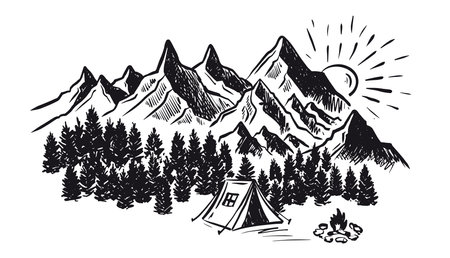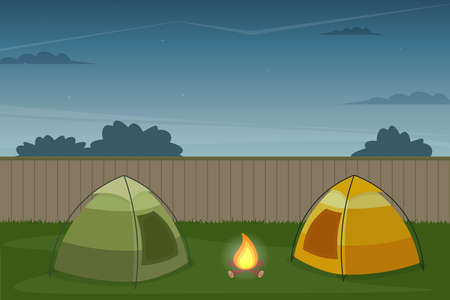Roots of Shelter: Traditional Tent Craftsmanship
Before the age of high-tech outdoor gear, tents were born from necessity and shaped by the environments and cultures that crafted them. Native American tipis are a prime example—ingeniously designed for mobility and resilience against the Great Plains’ harsh winds, their conical forms allowed for quick assembly and warmth retention. Across North America, early settlers and explorers relied on canvas wall tents, whose heavy-duty fabric and wood frames provided shelter during long expeditions or in remote wilderness camps. These traditional shelters were more than just protection from the elements; they reflected deep connections to land, community, and resourcefulness. The artistry in hand-sewn seams, careful selection of natural materials, and time-honored construction techniques gave these tents a unique character—each one echoing stories of survival, ritual, and adaptation. From indigenous wisdom to pioneer practicality, these roots of tent-making laid the foundation for today’s innovations in outdoor living.
2. A Shift in Materials: The Rise of Nylon and Polyester
The post-war era marked a transformative moment in the world of camping and outdoor adventure. As America embraced innovation and exploration, tent design took a giant leap forward with the introduction of synthetic fabrics like nylon and polyester. Gone were the days when heavy canvas shelters weighed down every trip. Suddenly, families, backpackers, and road-trippers alike could access lightweight, packable tents that matched their desire for freedom and spontaneity.
From Canvas to Cutting-Edge: Material Comparisons
| Material | Era | Weight | Water Resistance | Durability | Packing Size |
|---|---|---|---|---|---|
| Cotton Canvas | Pre-1950s | Heavy | Moderate (improves when wet) | Very Durable | Bulky |
| Nylon | 1950s onward | Lightweight | Excellent (with coatings) | High (but can degrade under UV) | Compact |
| Polyester | 1960s onward | Lightweight | Excellent (holds coatings well) | Very Durable (better UV resistance than nylon) | Compact |
Sparking a New Era of Outdoor Living
The adoption of these innovative materials wasnt just a technical upgrade—it was a cultural shift. Suddenly, camping became accessible for everyone from young scouts to seasoned mountaineers. Tents could now be tossed into the back of a station wagon or lashed to a hiking pack without a second thought. American families flocked to national parks, while college students set out on road trips with gear that reflected the spirit of adventure. The rise of nylon and polyester tents truly democratized outdoor recreation, setting the stage for further advancements in high-tech gear.

3. Design for Adventure: Specialty Tents for Every Environment
As America’s passion for the great outdoors has flourished, tent design has kept pace, evolving from one-size-fits-all shelters to specialized gear crafted for every type of adventure. Today’s market is packed with tents engineered specifically for backpacking, car camping, and even mountaineering—each style reflecting the unique needs and aspirations of outdoor enthusiasts across the country.
Backpacking Tents: Lightweight Freedom
For those who crave the freedom of hiking deep into backcountry trails, ultralight backpacking tents are a game-changer. These tents prioritize minimal weight and compactness, often utilizing high-tech materials like ripstop nylon and featherlight aluminum poles. Quick setups, innovative ventilation systems, and clever space-saving designs make them a favorite among thru-hikers and weekend wanderers alike.
Car Camping Tents: Comfort Meets Convenience
Americans’ love affair with road trips and national parks has fueled a surge in roomy, feature-packed car camping tents. These models focus on comfort—think tall ceilings for standing room, separate rooms or vestibules for gear storage, and instant-pitch mechanisms that turn setup into a breeze. Many families now enjoy their own “home away from home,” complete with lantern hooks and oversized windows to soak in the stars.
Mountaineering Tents: Built for Extremes
When adventure calls in harsh alpine environments, mountaineering tents rise to the challenge. Designed to withstand whipping winds, heavy snow loads, and subzero temperatures, these four-season shelters incorporate robust fabrics, reinforced guy lines, and geometric pole structures for maximum stability. Their innovation reflects an American spirit of pushing boundaries—whether summiting Denali or braving winter storms in the Rockies.
The American Outdoor Ethos
This boom in specialty tent designs not only mirrors advances in technology but also celebrates Americans’ relentless pursuit of nature’s diversity—from sun-soaked deserts to misty forests and snowy peaks. As outdoor lifestyles continue to inspire new adventures, tent makers keep reimagining what it means to call the wild home—even if just for a night under the stars.
4. Innovation Under the Stars: The Integration of Technology
Camping isn’t just about roughing it anymore—it’s about embracing the great outdoors with a touch of high-tech comfort. Over the last decade, tent design has truly leveled up, blending classic shelter concepts with innovative technology to create an entirely new camping experience. Whether you’re setting up base at Yosemite or tailgating before a big game, modern tents now cater to every adventure with remarkable features that make life outside even better.
Game-Changing Tent Features
Today’s campers expect more than just protection from the elements—they want convenience, durability, and a little bit of luxury under the stars. Here are some standout advancements shaping the latest tents:
| Feature | Description | Why It Matters |
|---|---|---|
| Instant Setup Poles | Pre-attached or telescopic poles allow for quick, hassle-free pitching—some pop-up models are ready in seconds. | No more wrestling with tangled poles; perfect for families and solo adventurers alike. |
| Weather-Resistant Coatings | Advanced waterproofing, UV protection, and wind-resistant materials ensure your tent stands strong in any forecast. | Stay dry during Midwest thunderstorms or cool under the Southwest sun—no surprises when Mother Nature turns wild. |
| Smart Tech Integrations | Built-in LED lighting, USB ports, and Bluetooth speakers bring creature comforts to the campsite. | Add ambiance and connectivity without extra gadgets cluttering your gear. |
| Climate Control Systems | Integrated vents, air circulation panels, and even mini AC units regulate temperature for a restful night’s sleep. | Wake up refreshed after a humid night in Florida or chilly dawn in Colorado. |
| Solar Power Panels | Tents equipped with solar panels can charge your phone or lantern directly from the sun’s rays. | Sustainable energy means you’re never out of touch—even off-grid in Big Sur or Zion. |
The High-Tech Camping Lifestyle
The integration of technology into tent design hasn’t just made camping easier—it’s changed what it means to spend time outdoors. Now, outdoor enthusiasts can enjoy a seamless blend of nature and innovation. Imagine streaming your favorite playlist while roasting s’mores, charging your camera for sunrise shots, or staying cozy through sudden weather swings—all without leaving your tent. These advances empower both seasoned explorers and weekend warriors to focus on making memories rather than managing gear. As technology continues to evolve, so does our connection to the wild—proving that even under the stars, modern living can feel right at home.
5. Aesthetic Elevation: Melding Function and Style
In recent years, tent design has taken a bold leap from purely utilitarian roots to embrace an exciting fusion of form and function. Today’s modern tents are crafted not only for shelter but also to make a statement—reflecting the American love for comfort, individuality, and visually stunning experiences. Designers now understand that outdoor enthusiasts crave more than just protection from the elements; they desire gear that complements their lifestyle, stands out in a sea of sameness, and looks good both in person and on social media feeds.
Instagram-Worthy Experiences
Social media culture, especially Instagram, has played a significant role in shaping the aesthetics of contemporary tents. Sleek silhouettes, earth-toned palettes, and playful pops of color have become hallmarks of high-end tent brands. Spacious interiors, panoramic windows, and innovative lighting options transform ordinary campsites into cozy retreats perfect for capturing those magical golden-hour moments. The result? Tents that don’t just blend into nature—they elevate it, providing backdrops as photogenic as the landscapes themselves.
Comfort Meets Beauty
The American appetite for comfort isn’t forgotten. Thoughtful features such as plush floor mats, modular layouts, and easy-access doors bring home-like coziness outdoors. At the same time, minimalist profiles and refined materials ensure that style is never sacrificed for utility. Whether it’s glamping with friends or a solo adventure in the wild, today’s tents reflect a new era where every detail—from zipper pulls to rainfly patterns—is curated to delight both the practical camper and the style-conscious explorer.
Designing for Diverse Tastes
The evolution of tent aesthetics also means catering to a wider variety of outdoor lifestyles. Urban dwellers seeking weekend escapes might opt for chic pop-up domes with transparent ceilings, while seasoned backpackers gravitate toward ultralight models boasting sleek lines and vibrant accents. No matter your preference, there’s a tent that captures your spirit—and looks incredible on camera. This harmony of function and beauty redefines what it means to camp American-style: it’s about celebrating the outdoors in comfort, confidence, and undeniable style.
6. Toward a Greener Camp: Sustainable and Eco-Friendly Tents
As environmental awareness continues to grow across the United States, the outdoor gear industry is embracing a new frontier: sustainability. Tent design, once focused solely on durability and performance, is now evolving to address the ecological footprint of both materials and manufacturing processes. This shift is not just a trend but a response to the increasing demand from American campers for gear that aligns with their eco-conscious values.
The Rise of Recycled and Renewable Materials
Modern tent manufacturers are exploring innovative materials such as recycled polyester made from post-consumer plastic bottles and organic cotton canvas. These alternatives help minimize waste and reduce reliance on virgin resources. Some brands have even introduced biodegradable coatings and dyes, ensuring that every aspect of the tent’s construction is considered through an environmentally friendly lens.
Eco-Certifications and Transparent Sourcing
Transparency in sourcing has become a hallmark of reputable tent brands. Many now seek certifications like bluesign® or Global Recycled Standard (GRS), which guarantee responsible production methods and traceable supply chains. For American consumers, these certifications provide reassurance that their outdoor adventures aren’t coming at the planet’s expense.
Durability Over Disposability
A key principle in sustainable tent design is longevity. Rather than producing low-cost, disposable tents that end up in landfills after a single festival or camping trip, many U.S. companies focus on crafting products meant to last for years—even decades. Repair kits, modular designs, and easily replaceable parts further extend the life cycle of modern tents, reducing overall waste.
From Green Initiatives to Community Impact
Sustainability efforts go beyond materials; many tent makers are also investing in carbon offset programs and supporting conservation projects in America’s wild spaces. By fostering a culture of stewardship within the outdoor community, these brands are inspiring campers to leave no trace—helping ensure that future generations can enjoy the same starry nights and serene mornings under canvas or high-tech fabric alike.
The journey from traditional tents to high-tech gear has been marked by remarkable innovation, but perhaps its most meaningful chapter is being written now—with a commitment to preserving the natural beauty that draws us outdoors in the first place.

